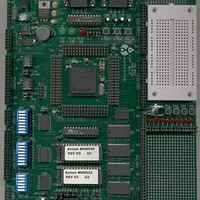MPC555CME Freescale Semiconductor, MPC555CME Datasheet - Page 515

MPC555CME
Manufacturer Part Number
MPC555CME
Description
KIT EVALUATION FOR MPC555
Manufacturer
Freescale Semiconductor
Type
Microcontrollerr
Datasheet
1.MPC555CME.pdf
(966 pages)
Specifications of MPC555CME
Contents
Module Board, Installation Guide, Power Supply, Cable, Software and more
Processor To Be Evaluated
MPC555
Data Bus Width
32 bit
Interface Type
RS-232
For Use With/related Products
MPC555
Lead Free Status / RoHS Status
Contains lead / RoHS non-compliant
- Current page: 515 of 966
- Download datasheet (13Mb)
MPC555
USER’S MANUAL
SCCxR1 determines whether TXD is an open drain (wired-OR) output or a normal
CMOS output. An external pull-up resistor on TXD is necessary for wired-OR opera-
tion. WOMS controls TXD function, regardless of whether the pin is used by the SCI
or as a general-purpose output pin.
Data to be transmitted is written to SCxDR, then transferred to the serial shifter. Before
writing to TDRx, the user should check the transmit data register empty (TDRE) flag
in SCxSR. When TDRE = 0, the TDRx contains data that has not been transferred to
the shifter. Writing to SCxDR again overwrites the data. If TDRE = 1, then TDRx is
empty, and new data may be written to TDRx, clearing TDRE.
As soon as the data in the transmit serial shifter has shifted out and if a new data frame
is in TDRx (TDRE = 0), then the new data is transferred from TDRx to the transmit se-
rial shifter and TDRE is set automatically. An interrupt may optionally be generated at
this point.
The transmission complete (TC) flag in SCxSR shows transmitter shifter state. When
TC = 0, the shifter is busy. TC is set when all shifting operations are completed. TC is
not automatically cleared. The processor must clear it by first reading SCxSR while TC
is set, then writing new data to SCxDR, or writing to SCTQ[0:15] for transmit queue
operation.
The state of the serial shifter is checked when the TE bit is set. If TC = 1, an idle frame
is transmitted as a preamble to the following data frame. If TC = 0, the current opera-
tion continues until the final bit in the frame is sent, then the preamble is transmitted.
The TC bit is set at the end of preamble transmission.
The SBK bit in SCCxR1 is used to insert break frames in a transmission. A non-zero
integer number of break frames are transmitted while SBK is set. Break transmission
begins when SBK is set, and ends with the transmission in progress at the time either
SBK or TE is cleared. If SBK is set while a transmission is in progress, that transmis-
sion finishes normally before the break begins. To ensure the minimum break time,
toggle SBK quickly to one and back to zero. The TC bit is set at the end of break trans-
mission. After break transmission, at least one bit-time of logic level one (mark idle) is
transmitted to ensure that a subsequent start bit can be detected.
If TE remains set, after all pending idle, data and break frames are shifted out, TDRE
and TC are set and TXD is held at logic level one (mark).
When TE is cleared, the transmitter is disabled after all pending idle, data, and break
frames are transmitted. The TC flag is set, and control of the TXD pin reverts to
PQSPAR and DDRQS. Buffered data is not transmitted after TE is cleared. To avoid
losing data in the buffer, do not clear TE until TDRE is set.
Some serial communication systems require a mark on the TXD pin even when the
transmitter is disabled. Configure the TXD pin as an output, then write a one to either
QDTX1 or QDTX2 of the PORTQS register. See 14.6.1. When the transmitter releases
control of the TXD pin, it reverts to driving a logic one output.
/
MPC556
QUEUED SERIAL MULTI-CHANNEL MODULE
Rev. 15 October 2000
MOTOROLA
14-53
Related parts for MPC555CME
Image
Part Number
Description
Manufacturer
Datasheet
Request
R

Part Number:
Description:
MPC555 Interrupts
Manufacturer:
Freescale Semiconductor / Motorola
Datasheet:
Part Number:
Description:
Manufacturer:
Freescale Semiconductor, Inc
Datasheet:
Part Number:
Description:
Manufacturer:
Freescale Semiconductor, Inc
Datasheet:
Part Number:
Description:
Manufacturer:
Freescale Semiconductor, Inc
Datasheet:
Part Number:
Description:
Manufacturer:
Freescale Semiconductor, Inc
Datasheet:
Part Number:
Description:
Manufacturer:
Freescale Semiconductor, Inc
Datasheet:
Part Number:
Description:
Manufacturer:
Freescale Semiconductor, Inc
Datasheet:
Part Number:
Description:
Manufacturer:
Freescale Semiconductor, Inc
Datasheet:
Part Number:
Description:
Manufacturer:
Freescale Semiconductor, Inc
Datasheet:
Part Number:
Description:
Manufacturer:
Freescale Semiconductor, Inc
Datasheet:
Part Number:
Description:
Manufacturer:
Freescale Semiconductor, Inc
Datasheet:
Part Number:
Description:
Manufacturer:
Freescale Semiconductor, Inc
Datasheet:
Part Number:
Description:
Manufacturer:
Freescale Semiconductor, Inc
Datasheet:
Part Number:
Description:
Manufacturer:
Freescale Semiconductor, Inc
Datasheet:
Part Number:
Description:
Manufacturer:
Freescale Semiconductor, Inc
Datasheet:










